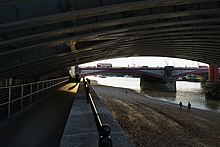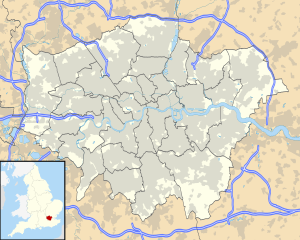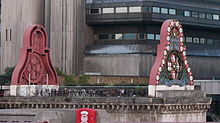Blackfriars Railway Bridge
Coordinates: 51 ° 30 ′ 35 ″ N , 0 ° 6 ′ 12 ″ W.
| Blackfriars Railway Bridge | ||
|---|---|---|
| Blackfriars Railway Bridge with the remains of the old bridge in the foreground | ||
| use | Railway bridge | |
| Crossing of | Thames | |
| place | London | |
| construction | 1st bridge: wrought iron lattice bridge with piers made of cast iron and masonry 2. Bridge: wrought iron arch bridge on piers made of masonry |
|
| overall length | 284 m | |
| Number of openings | 5 | |
| opening | 1st bridge: 1864 2nd bridge: 1886 |
|
| planner | 1st bridge Joseph Cubitt 2nd bridge: John Wolfe-Barry , Henry Marc Brunel |
|
| closure | 1st bridge: 1971 (superstructure demolished in 1985) | |
| location | ||
|
|
||
The Blackfriars Railway Bridge (until 1937 St Paul's Railway Bridge ) is a railway bridge over the River Thames in London . It forms the main entrance to Blackfriars station in the Blackfriars district on the western border of the City of London .
First bridge
In 1860 the London, Chatham and Dover Railway (LC&DR) had received permission to extend its route from Beckenham to Ludgate Hill in the City of London . Since the architect Joseph Cubitt was building the road bridge right next to the future structure at the same time , he was also assigned the planning of the railway bridge. He designed a five-span wrought-iron lattice bridge that was supported by cast iron columns. The bridge had four tracks and was opened in 1864. It was initially called similar to the adjacent St Paul's Railway Bridge station .
Second bridge
The increasing rail traffic soon overwhelmed the structure. To relieve the strain, engineers John Wolfe-Barry and Henri Marc Brunel built a second bridge just a few meters further east of the existing bridge from 1884 to 1886 . The bridges were also renamed in 1937 with the renaming of the long-distance train station in Blackfriars and newly designated as Blackfriars Railway Bridge .
Demolition of the first bridge
In the middle of the 20th century, the strength of the older part of the railway bridge was no longer sufficient for modern trains, so that from 1971 only the bridge from 1886 was used. The older bridge was demolished in 1984 except for the brick pillars with the cast iron pillars. Only on the south bank did the massive supports with the restored emblem of the historic LC&DR railway company remain.

Blackfriars train station
The pillars of the old bridge were partly reused as part of the Thameslink program . The eastern row of old pillars, together with the newer bridge, supports the extended platforms of Blackfriars station .
Since 2014 the bridge has had a "roof" made up of 4,400 solar modules (a total of 6000 m²). This should generate 900,000 kWh of electricity annually and use it for rail operations. This corresponds to half of the electricity requirements of the nearby Blackfriars train station, 511 tons of CO 2 would be saved.
Web links
- Blackfriars Railway Bridge. In: Structurae
- Blackfriars Railway Bridge. In: Where Thames smooth waters glide. Retrieved May 26, 2013 .
Individual evidence
- ↑ London: world's largest solar bridge inaugurated. In: klimaretter.info . January 27, 2014, accessed April 22, 2015 .
|
upriver Blackfriars Bridge |
River crossings of the Thames |
downstream Millennium Bridge |





